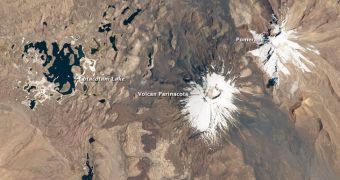Expedition 29 astronauts aboard the International Space Station recently snapped this image of Volcan Parinacota from orbit, using a Nikon D2Xs digital camera with a 400 mm lens. The view shows a potentially active stratovolcano in the Andes mountains of west-central South America.
This photo was released by the ISS Crew Earth Observations experiment and Image Science & Analysis Laboratory, which is based at the NASA Johnson Space Center (JSC), in Houston, Texas.
According to geological studies, the last volcanic eruption occurred around 290 AD, give or take 300 years. This is very recent in geological times, and by no means an indicator that the volcano has stopped being active. At this point, it shows no signs of trouble.
Its companion to the northwest, the Pomerape volcano, last erupted between 3 million to 12,000 years ago, during a geological time called the Pleistocene Epoch. It is somewhat unlikely that it will erupt soon, but researchers cannot say for certain that it is inactive.

 14 DAY TRIAL //
14 DAY TRIAL //